-
近年来,随着人们对于资源衰减问题的日益关注,大家开始更加注重废弃资源的循环利用。有数据显示,2015年我国污泥产量超过3 000×104 t,畜禽废弃物排放总量接近38×108 t,并且都呈现不断增长的趋势[1-3]。如何有效利用这些废弃资源成为当前研究的热点。蚯蚓堆肥(vermicomposting)是利用蚯蚓和微生物,将有机废弃物进行快速有效地分解并将其转换成腐殖质的处理方法,是一种生态环境友好的堆肥技术[4]。相对于自然堆肥,蚯蚓堆肥处理更加有效,对有机废弃物具有很大的分解、处理潜力[5]。同时,蚯蚓堆肥较普通堆肥能产生碳氮比更加适宜、营养更高的优质肥料[4]。
污泥作为污水处理的产物,富含大量有机成分和矿物质营养元素,但不加任何处理的污泥用于土地利用会对土壤和植物产生不利影响,对其进行适当稳定化处理是其资源化利用的首要条件。蚯蚓堆肥已经广泛应用在处理城市污泥和工业污泥方面[6-9]。但工业污泥中常含有重金属和各种有机污染物,加上自身较低的碳氮比都会抑制蚯蚓活动,阻碍其生长和繁殖,进而影响蚯蚓堆肥的效率[5,10]。另外,有学者认为新鲜污泥很容易产生有毒害作用的渗滤液,形成蚯蚓无法生存的厌氧环境,并不适合直接用于蚯蚓堆肥[11]。因此,在堆肥过程中常常使用各种填充剂作为改性物料,来改善污泥的理化性质,消除污泥毒性,保证蚯蚓的生长环境,以期获得更为理想的堆肥效果。目前,最常用的填充剂是牛粪[10],它非常适宜蚯蚓的生长繁殖[5],类似的还有生物炭[12]、水稻壳[13]、粉煤灰[14]、甘蔗渣[15]等。其中,园林废弃物作为一种潜在的废弃资源,同样具有巨大的利用价值[16]。但国内外关于比较污泥中添加园林废弃物和牛粪对蚯蚓堆肥影响的研究较少。根据以往研究[13-15],蚯蚓在不同物料的混合物中会表现出不同的生长和繁殖状况。因此,选择适宜的物料和相应的混合比例至关重要。本研究以赤子爱胜蚓作为供试蚯蚓,探讨了园林废弃物和牛粪与污泥的不同配比对蚯蚓生长繁殖和物料理化性质的影响,为蚯蚓堆肥技术的资源化利用提供参考。
全文HTML
-
供试蚯蚓为大平2号,取自上海市某蚯蚓养殖场;污泥取自上海市某污水处理厂,污泥类型为工业污泥;牛粪取自上海某养殖场;园林废弃物取自上海交通大学植物园;3种物料的基本理化性质如表1所示。实验装置为上径170 mm、下径123 mm、高131 mm的塑料盆。
-
将3种物料(污泥、牛粪和园林废弃物)风干研磨,过5 mm筛子。按照表2所示的比例(质量分数)将牛粪和园林废弃物分别与污泥进行混合,每盆加入450 g物料(干质量),用去离子水使混合物料含水率达到70%,每个处理设置3个重复。
蚯蚓取回后在室内用牛粪养殖一段时间。然后根据蚯蚓最适密度的研究结果[17],向每个处理组中加入30条大小均匀、平均体质量在0.4 g左右、带有明显环带的蚯蚓。将所有装置放入恒温生长箱中,进行为期60 d的堆肥处理。实验期间控制温度在(23±2) ℃,并且每天向其中喷水,保证含水率在70%左右。
第0、10、20、30、40、50、60天进行破坏性采样,把所有蚯蚓从混合物中分离出来,观察生长状况,统计蚯蚓数量,并称质量,同时,对每个处理组的蚓茧数目进行计数,计数后不放回。在第0天和第60天收集堆肥物料进行物理化学性质分析。堆肥60 d完成后,分离出所有的蚯蚓和蚓茧。
-
样品经1∶10土水比浸提1 h,离心后用pH计和电导率仪测定pH和EC;采用HJ 761-2015中的灼烧减量法测定有机质;采用半微量凯氏定氮法测定总氮;采用高氯酸-浓硫酸酸溶-钼锑抗比色法测定总磷;采用氢氧化钠熔融-火焰光度法测定总钾[18]。
蚯蚓生长繁殖测定的相关参数[19]按照式(1)~式(4)计算。
式中:S为蚯蚓存活率;Nt为t时存活的蚯蚓条数,条;Wa为蚯蚓平均体质量,g;Wt为t时的蚯蚓总重,g;W0为初始蚯蚓总重,g;Ma为日增重倍数;Ct为t时蚯蚓累计产茧量,个;Ca为日产茧数,个;t为处理时间,d。
-
采用Microsoft Excel 2019进行数据处理,Origin 9.60绘制曲线图,采用SPSS 20.0软件对数据进行方差分析和多重比较,采用Canoco 5软件进行冗余分析(RDA)。
1.1. 供试材料
1.2. 实验方法
1.3. 测试方法
1.4. 数据分析
-
蚯蚓堆肥过程中pH和EC的变化情况如表3所示。除T1(D1)外,所有处理组pH在60 d前后都呈现显著差异。不同处理组的pH变化幅度为0.20%~25.82%。其中D5的变化最大,由6.75升高到8.48,而T1的变化幅度最小。相对初始值,pH均向中性趋势变化。ELVIRA等[20]研究表明,蚯蚓堆肥过程中微生物分解产生的二氧化碳和有机酸会降低底物的pH。同样,NDEGWA等[21]和FU等[22]指出,堆肥中pH的变化可能与氮和磷矿化为亚硝酸盐/硝酸盐和正磷酸盐以及有机质转化为有机酸的中间产物有关。T5与D5等不同处理间pH呈现不同的变化趋势则可能是底物的差异引起的。不同堆肥物料分解过程中会产生不同的中间代谢物。KHARRAZI等[23]认为蚯蚓堆肥过程中pH升高是由于有机化合物的分解生成大量氨所导致的。
与其他几项蚯蚓堆肥的研究结果[24-25]类似,所有处理组的EC都显著高于初始值。其中T5的变化最大,上升了126.93%。其他各组处理的EC变化幅度为18.86%~51.17%,T1的改变幅度最小。EC的升高可能是由于无机离子和可溶性盐的释放,如磷酸盐,铵盐和硝酸盐[26]。这一现象表明蚯蚓堆肥可以加速有机质的矿化,从而使不溶性微粒转变为可溶性形态[27]。
由图1(a)可知,所有处理组的有机质含量堆肥前后都呈现显著差异。堆肥处理60 d后,有机质含量较初始状态损失为3.22%~12.84%,D4变化最大,T1最小。SUTHAR等[15]认为,不同物料的物理性质和化学成分直接影响蚯蚓对有机物的降解速率。蚯蚓通过自身活动加速物料的分解和矿化,促进微生物的代谢活动,最终有机组分以CO2的形式分解,这是造成碳素损失的主要原因[26]。DOMINGUEZ等[28]认为,蚯蚓堆肥的过程就是蚯蚓和微生物的联合作用。物料经过蚯蚓砂囊和肠道被磨碎分解,并附加一些黏液和酶,从而增加了微生物作用的表面积,进而促进微生物的高效降解。同时,物料中有机组分转化为蚯蚓的生物量也是造成碳素损失的原因之一。
由图1(b)~(d)可以看出,堆肥60 d后物料中的总氮、总磷和总钾均有不同程度的升高。各处理组的总氮堆肥前后都有显著差异,增幅为7.19%~32.38%,D5变化最大,T1变化最小。有研究[29]表明,蚯蚓在堆肥过程中向物料中添加排泄物、黏液、体液、酶等,会造成氮含量的增加。同时,死亡蚯蚓的腐烂组织也为蚯蚓堆肥的系统中增加了大量的氮素。一般来说,蚯蚓的身体组织中含有大约60%~70%的蛋白质,其中的氮素最终通过矿化返还到土壤中。此外,蚯蚓和微生物消耗基质以及有机物在降解过程中蒸发失水,导致干物质减少也可能是总氮增加的原因[30]。
除T1外,所有处理组最终蚯蚓堆肥产物的总磷和总钾含量都显著高于初始堆肥物料。T5处理组对总磷和总钾含量的增幅最大,分别增加了103.30%、81.98%。T5到T1全磷全钾的变化幅度依次降低,T1的磷钾变化最小。随着污泥比例的增加,磷和钾的矿化速率呈下降趋势,这可能是由于基质中重金属和其他有毒有害物质增加所致。高比例污泥会导致蚯蚓的高死亡率和低活力,进而影响蚯蚓的生命活动和物料的矿化速率。此外,有机质的含量与微生物种群及其矿化作用有直接关系,在分解过程中起着重要作用。在污泥比例升高的同时,有机质含量也会随之降低,造成不同处理组间矿化速率的差异。
磷和钾含量的升高可能是由于有机物质分解、释放二氧化碳以及矿化作用导致物料质量下降、不稳定有机化合物的降解,磷钾在物料中的比例增加所致[31]。蚯蚓体内细菌和排泄物中磷酸酶对磷的矿化和活化也可能是物料中磷含量增加的主要原因[32]。微生物的产酸作用和通过增加微生物活性来提高矿化速率在溶解不溶性磷、钾方面发挥着重要的作用[33-34]。
-
1)蚯蚓的存活率。如图2(a)所示,在污泥与牛粪的不同配比中,蚯蚓都出现了不同程度的死亡情况。堆肥60 d后,各处理蚯蚓的存活率为44.44%~75.56%。其中,T1为纯污泥,在处理前期即出现大量死亡,20 d后,存活率维持在50%左右。通过前期观察发现,T1中的蚯蚓全部聚集在装置底部,活跃性较差。T2、T3、T4呈现相似的存活率变化趋势。T2的存活率整体偏高,表现出缓慢下降的趋势,60 d后,达到最低存活率,为70.00%。T3在前30 d死亡较多,30 d后,维持在60%的存活率。T4中蚯蚓在处理60 d后的存活率最高,虽然前30 d也出现一定程度的死亡,但30 d后趋于稳定。T5处理蚯蚓的存活率在前30 d比较稳定,但在处理的30~40 d,出现急剧下降,之后趋于稳定。在污泥与园林废弃物的配比中(图2(b)),除D1纯污泥处理外,各配比的蚯蚓生存状况良好,存活率都维持在95%以上,只有个别蚯蚓出现死亡或逃逸现象。由此可见,相同比例园林废弃物的添加相较牛粪对蚯蚓的存活率起到更为显著的改善效果。
SUTHAR等[15]在甘蔗渣和污泥配比的实验中得到相同的结论,污泥比例越高,蚯蚓的死亡率越高。不同比例物料中理化环境的改变直接影响蚯蚓的存活率。不适宜的pH可能是造成T1(100%污泥)中蚯蚓低存活率的原因。本研究所用污泥的初始pH为5.14,一般认为蚯蚓适宜的pH应在7.5左右[35]。同时,随着污泥比例的增加,重金属浓度也相应升高,同样会影响蚯蚓的生物活性[12]。此外,低比例污泥的蚯蚓存活率较高,还可能与其有机物含量更高有关。有机质的含量与蚯蚓外部食物来源有直接关系[36],并且有机质对有机污染物和重金属离子的络合和富集[37],也可能降低环境对蚯蚓的毒害作用。
2)蚯蚓的平均体质量和日增质量倍数。蚯蚓平均体质量的变化如图3所示。图3(a)中T处理组表现出2种不同的变化趋势。T1、T2、T3处理组平均体质量较初始体质量都呈现持续性下降的趋势,其中T1最为明显,由0.422 g降低至60 d后的0.158 g,下降了62.56%;T2和T3在60 d后分别下降了43.35%和33.45%。T4、T5的平均体质量均呈现先上升后下降的规律,在前20 d,平均体质量不断上升,第20天,分别达到0.561 g和0.613 g,之后2个处理的平均体质量均开始下降,T4较T5下降缓慢,且60 d后,平均体质量高于T5。在图3(b)中,D2、D4、D5在前40 d的平均体质量波动较小,维持在0.4 g左右,D5在40 d后快速降低,处理60 d的平均体质量仅为0.277 g,为初始体质量的70.94%。D3处理的平均体质量整体偏高,蚯蚓前20 d平均体质量不断上升,后达到0.530 g,趋于稳定,但同样在40 d后出现下降,60 d后降至0.432 g。
在图4中,T1、T2、T3的日增重倍数在处理的60 d内,全部在0以下。T1的下降速率最快。T5在5个处理中增加最为明显,但30 d后,日增重倍数开始变为负值。T4变化不明显,但是唯一处理组的日增重倍数50 d内全部在0以上。T1、T4、T5在第10天达到峰值。30 d之后,T1~T5的变化趋于平缓。D3、D4、D5都呈现偏峰形,其中D4、D5在第10天达到极大值后开始逐渐降低。D1和D2则在处理60 d内日增重倍数全部为负值。
SHARMA等[25]认为,如果原始物料是适宜的,蚯蚓就可以实现生物量的增长,但总体生物量的增长程度仍取决于饲料质量和环境条件。高比例的污泥有机质含量较低,同时,重金属污染严重可能是造成平均体质量持续下降的原因。有研究[38]表明,缺乏外部食物以及高重金属浓度均会导致蚯蚓体质量的下降,并抑制它们的繁殖。在处理的前30 d,有机物质含量最丰富,蚯蚓的体质量增加幅度也最大。一般来说,有机质含量高代表了富含腐殖质(胡敏酸、富里酸、胡敏素)等成分,而腐殖质与金属的络合和富集也是控制物料中重金属行为和其有效性的重要因素。此外,各处理组中蚯蚓的平均体质量在30 d左右快速下降,还可能与大量产茧有关。蚯蚓在第30天大量产茧进而消耗了自身物质,这可能是导致蚯蚓平均体质量在处理30 d后迅速下降的原因。
-
由图5可知,蚯蚓的产茧情况与其他学者[39]的研究结果类似,所有处理组中的蚯蚓均在10 d后开始产茧,在第30天产茧量最高。在图5(a)中,T1、T2、T3的蚯蚓产茧量很少,产茧量顺序为T3>T2>T1,在第30天,T3的产茧量最大,为13个,T4和T5的产茧量也有显著增加,两者产茧数量随处理时间的延长均呈先增加后降低的趋势,最大产茧数量分别为152个和265个,T5的产茧量较T4高出74.34%。由图5(b)可知,在污泥和园林废弃物的混合物料中,蚯蚓产茧数的整体变化趋势类似于污泥和牛粪的混合物料。D1、D2产茧量极低,D3、D4、D5产茧量有显著增加,并且在前30 d,产茧数量的增长速率为D5>D4>D3,第30天的产茧量分别是217、183、83个,呈现显著差异。图5(a)与图5(b)相比,相同的污泥添加比例,处理30 d时,T1和D1,T2和D2,T5和D5这3组差异不显著,而D3>T3、D4>T4且呈现显著差异。
不同处理组的日产茧数量见图6。在污泥和牛粪的配比中,T3、T4、T5分别在处理的20、30和40 d日产茧数最高,分别是0.049、0.266、0.531个。图6(b)中,D3、D4、D5均在处理40 d时日产茧数最高,分别是0.171、0.409、0.463个。同样,对于相同的污泥添加比例,30 d时日产茧数D3>T3、D4>T4。但在不添加任何污泥的情况下,处理60 d内日产茧数100%牛粪均高于100%园林废弃物(T5>D5)。
通过拟合各处理组60 d内的累计产茧量和污泥添加比例的相关性(图7)并进行研究,发现蚯蚓的累积产茧量和污泥的添加比例呈Harris模型,R2均达到0.999。在低比例污泥的情况下,添加牛粪的累计产茧量优于园林废弃物,但当污泥比例增大时(x>25%),选择添加园林废弃物更适合蚯蚓繁殖。
在污泥中添加一定比例园林废弃物/牛粪,均能明显增加蚯蚓繁殖产茧数。MALINSKA等[12]通过向污泥中添加生物炭,也得到相似的结果。随着污泥比例的增加,产茧量呈下降趋势,这应该与蚯蚓存活率有直接关系。不适合蚯蚓存活的理化环境同样影响着蚯蚓产茧。各处理在堆肥30 d后,产茧量持续下降的原因可能是有机物的消耗和种群密度的增加。同时,大量产茧导致种群密度的增加和养分的减少也是造成堆肥后期蚯蚓死亡和体重下降的主要原因。虽然在T5中观察到了更多的蚯蚓死亡,但其累计产茧量仍高于D5,这可能归因于牛粪比园林废弃物具有更好的适口性[5]。XING等[40]的研究结果表明,蚯蚓的繁殖能力与添加剂的化学性质和适口性有关,牛粪作为添加剂对污泥蚯蚓堆肥的产茧效果优于猪粪。
-
在不同物料的理化性质下,蚯蚓会表现出不同的生长和繁殖状况,通过冗余分析(RDA),能够阐明环境因子与蚯蚓生长繁殖之间的相互影响情况。如图8所示,前2个排序轴RDA1和RDA2分别解释了40.38%和11.27%的变化。同时,冗余分析结果表明,pH和TN对蚯蚓的生长繁殖的影响最为显著。此外,物料中的TP、有机质和TK含量等其他理化指标同样会影响蚯蚓的发育繁殖。pH是影响蚯蚓产茧及其平均体质量的主要参数,这与其他学者的研究结果[40]一致。GARG等[35]认为,蚯蚓可以在pH为5~9时保持活力,而在蚯蚓堆肥过程中,最理想的pH为7.5~8.0。因此,物料中pH适宜范围的控制对高效的堆肥过程有重要意义。TN和有机质对蚯蚓生长和产茧也有积极作用。蚯蚓和微生物在堆肥过程中起到主要的驱动作用,两者的生长代谢都需要大量的碳源和氮源来完成。适宜的碳氮比不仅可以显著影响它们的生长繁殖速率,还会改变蚯蚓种群结构分布[41]。VIG等[39]指出,碳氮比能够显示出有机废弃物的分解程度,往往较大幅度的碳氮比变化表明更大程度的降解,故被广泛作为堆肥成熟的重要指标之一。此外,EC对蚯蚓的存活具有负面影响。XING等[40]也报道了类似的研究结果,认为蚯蚓个体的最大重量与EC呈负相关关系。有研究[42-43]表明,饲料中的EC和pH是蚯蚓生存和生长的限制因素,较高的EC同样会影响蚯蚓系统中的生长和繁殖。高EC也在一定程度上解释了堆肥过程中污泥与牛粪配比中蚯蚓持续死亡的原因。同时值得注意的是,堆肥产物中高浓度可溶性盐应用于农业生产还可能会阻碍作物生长[44]。
2.1. 蚯蚓堆肥过程中理化指标的变化
2.2. 蚯蚓的生长状况
2.3. 蚯蚓的繁殖情况
2.4. 堆肥过程中理化指标对蚯蚓生长繁殖的影响
-
1)蚯蚓堆肥能够改善物料pH,增加EC,降低有机质含量,提高堆肥产物中氮、磷、钾的养分含量。同时,污泥中添加牛粪/园林废弃物能够有效改善物料的理化性质,加速污泥的稳定化,提高其肥料价值。
2)高比例的污泥会对蚯蚓的生长起到抑制作用,可能导致死亡。在污泥中添加牛粪/园林废弃物对蚯蚓生存起到明显的改善作用,既有利于蚯蚓生长也能降低蚯蚓死亡的风险。其中,园林废弃物的添加相较牛粪对蚯蚓的存活率的提高更为明显。
3)在污泥中添加一定比例园林废弃物/牛粪,可明显帮助蚯蚓繁殖产茧。污泥比例较低时,添加牛粪处理组的累计产茧量要高于添加园林废弃物处理组的,但当污泥比例大于25%时,添加园林废弃物的污泥更适合蚯蚓繁殖。
4)冗余分析结果表明,pH和TN对蚯蚓的生长繁殖起着重要的作用。其中,pH是影响蚯蚓产茧以及平均体质量的主要参数。TN和有机质对蚯蚓生长和产茧也有积极影响。此外,EC与蚯蚓存活率呈负相关。





 DownLoad:
DownLoad:

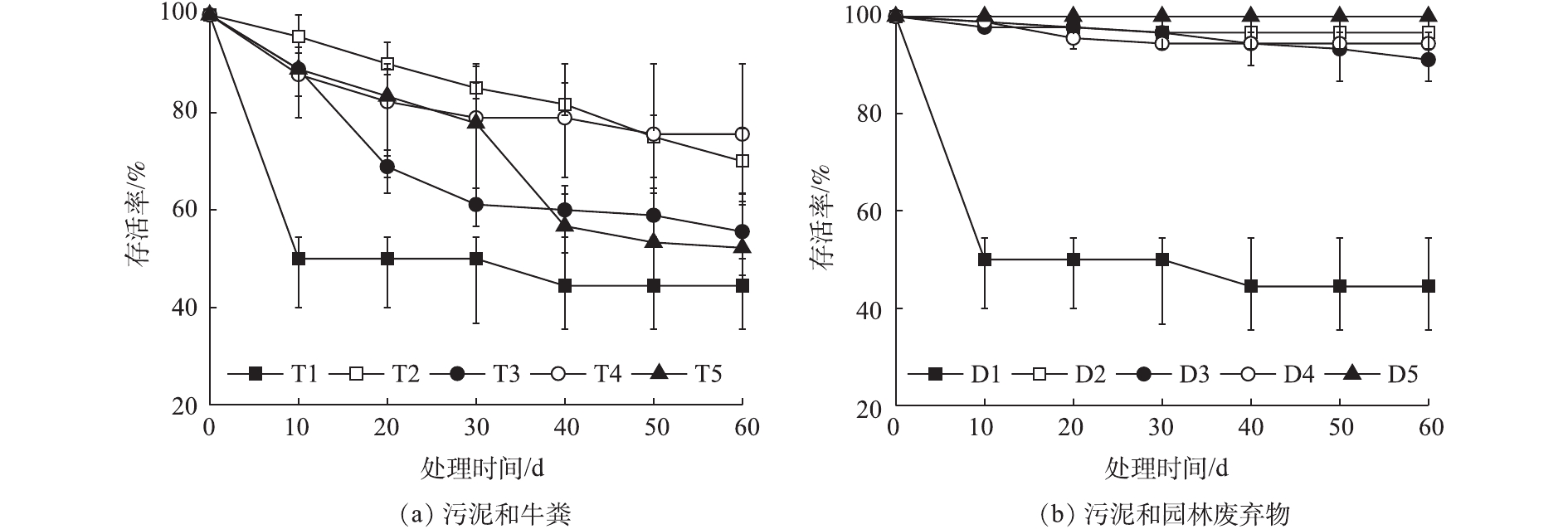

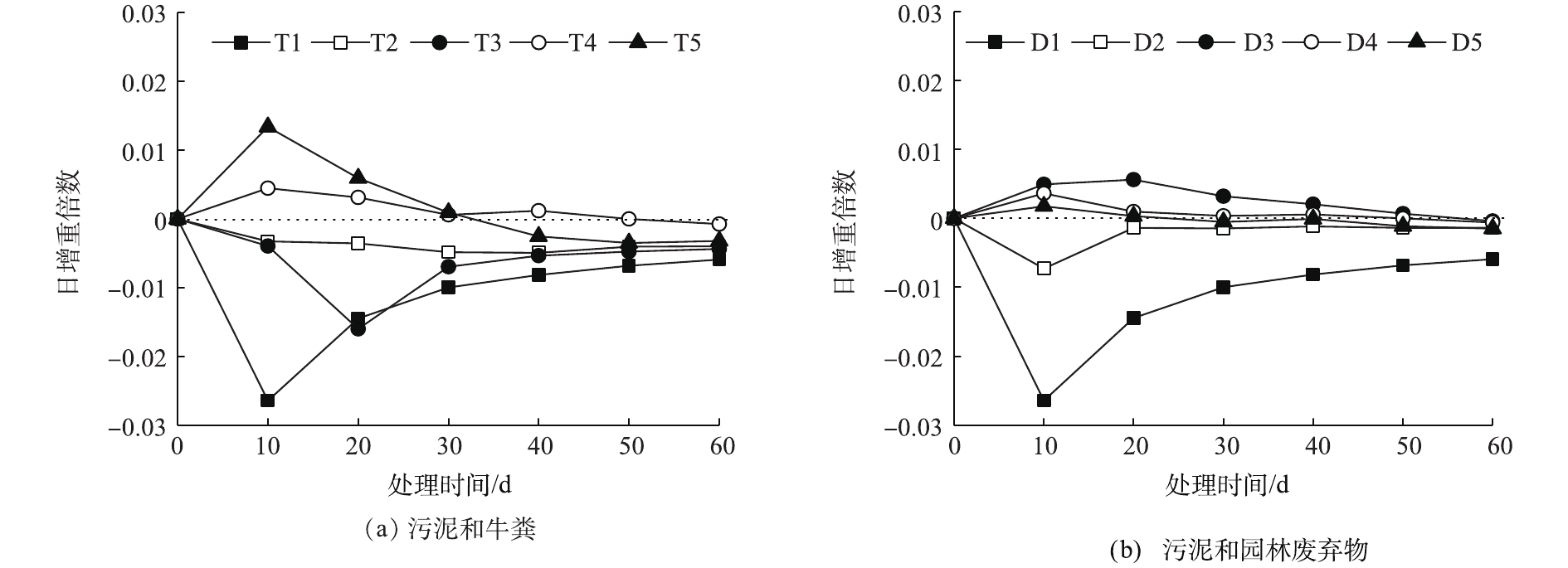
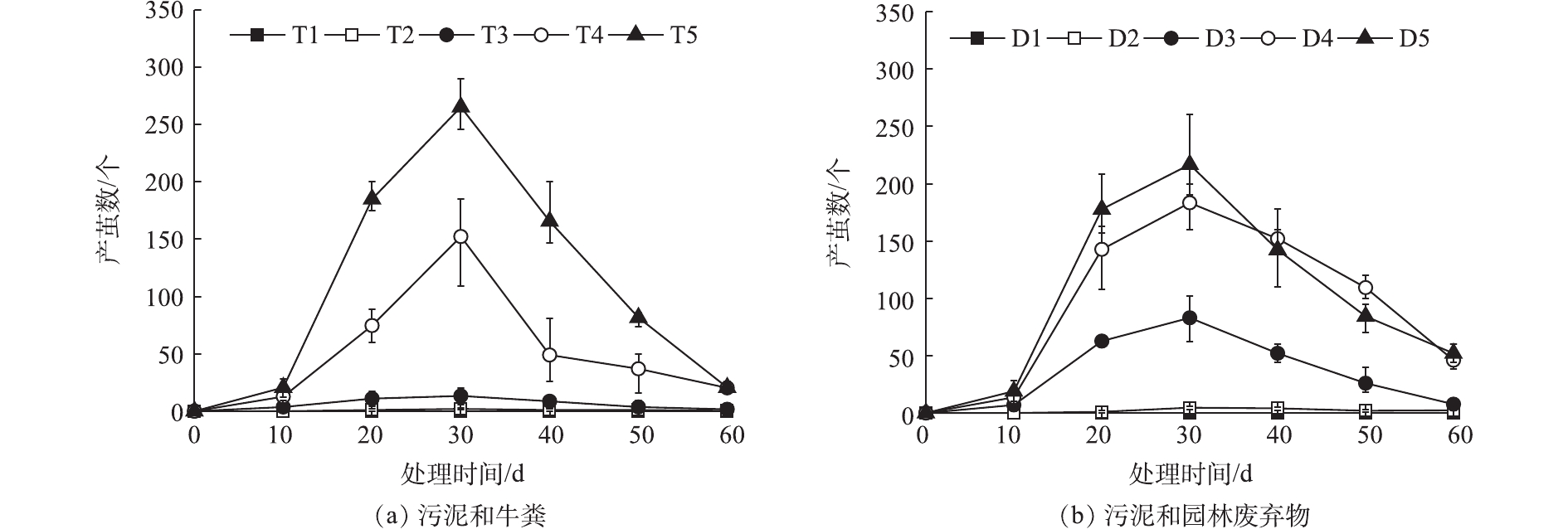
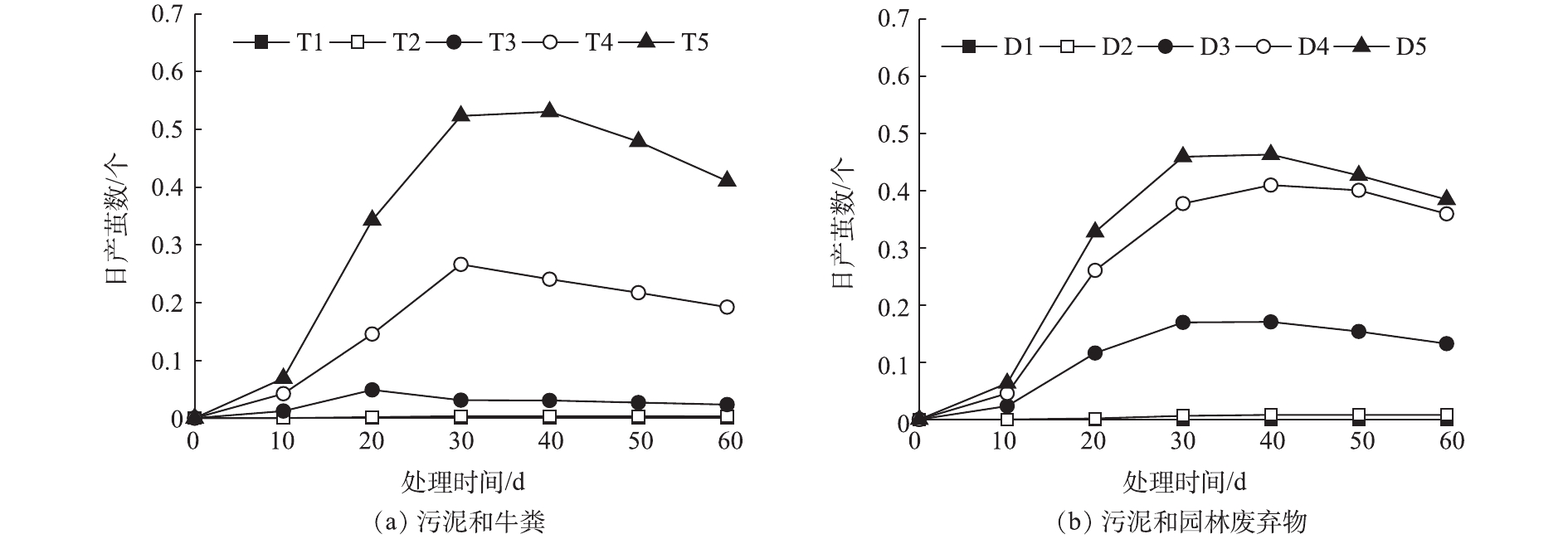
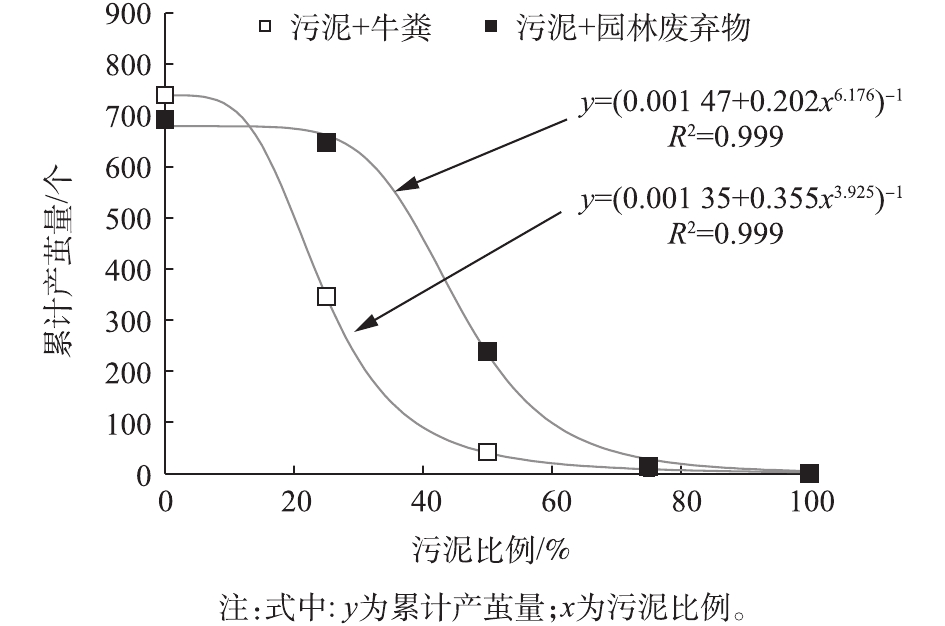
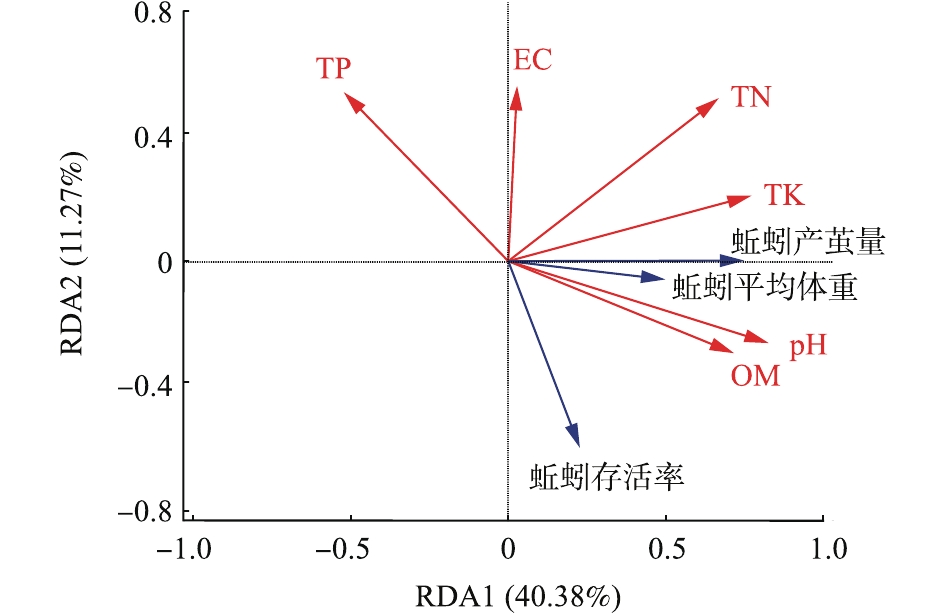
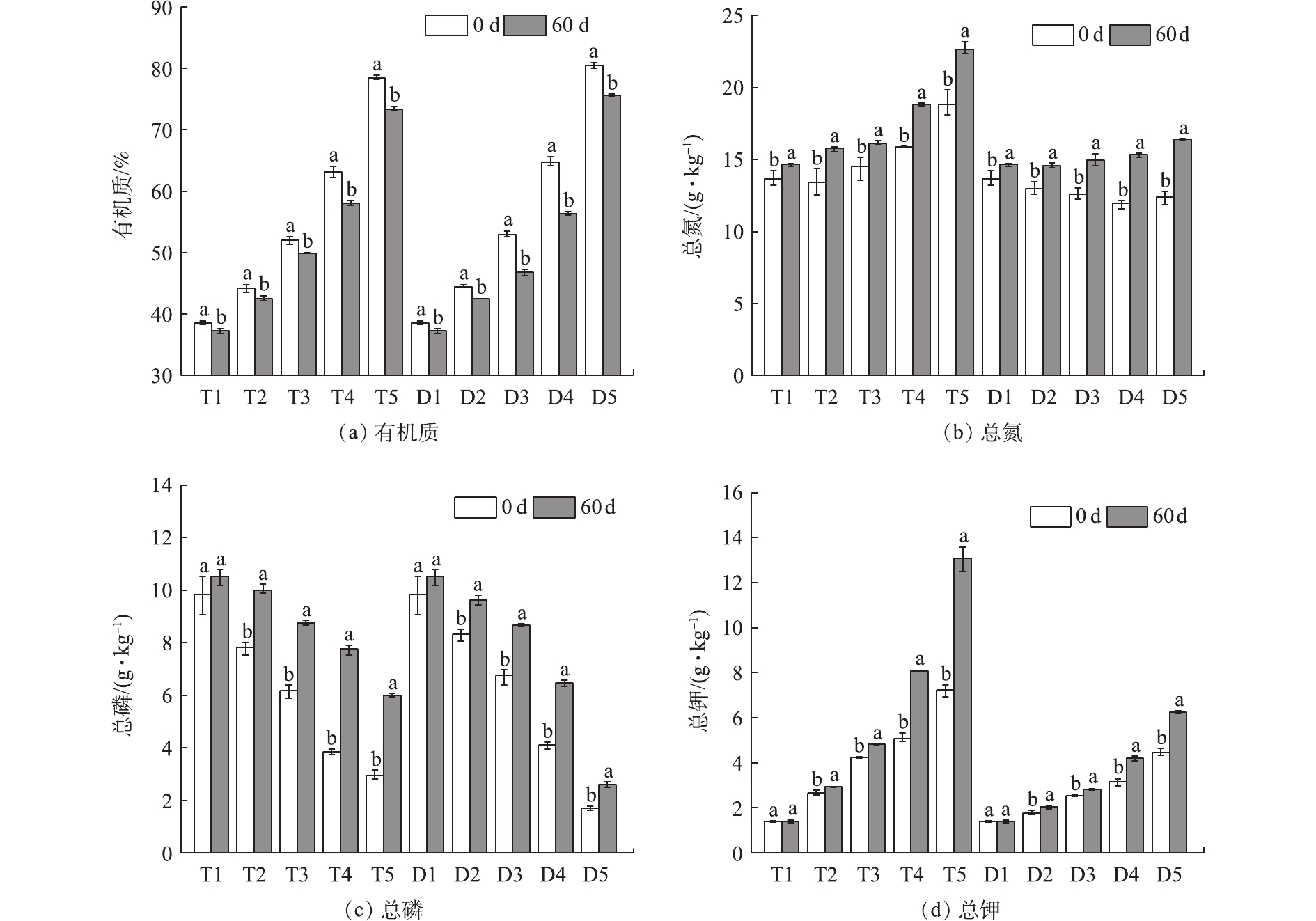







 百度学术
百度学术


